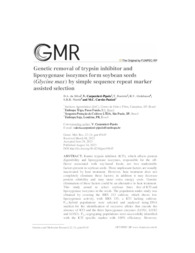Genetic removal of trypsin inhibitor and lipoxygenase isozymes form soybean seeds (Glycine max) by simple sequence repeat marker assisted selection.
Genetic removal of trypsin inhibitor and lipoxygenase isozymes form soybean seeds (Glycine max) by simple sequence repeat marker assisted selection.
Author(s): SILVA. D. A. da; CARPENTIERI-PIPOLO, V.; BARRETO, T.; ABDELNOOR, R. V.; MARIN, S. R. R.; CARRAO-PANIZZI, M. C.
Summary: Abstract: unitz trypsin inhibitor (KTI), which affects protein digestibility and lipoxygenase isozymes, responsible for the off-flavor associated with soy-based foods, are two undesirable factors present in soybean seeds. These unpleasant factors are usually inactivated by heat treatment. However, heat treatment does not completely eliminate these factors; in addition it may decrease protein solubility and may incur extra energy costs. Genetic elimination of these factors could be an alternative to heat treatment. This study aimed to select soybean lines free of KTI and lipoxygenase isozymes in the seeds. The population under study was obtained by crossing the BRS 213 cultivar, which shows low lipoxygenase activity, with BRS 155, a KTI lacking cultivar. F2:3 hybrid populations were selected and analyzed using DNA markers for the identification of recessive alleles that encode the absence of KTI and the three lipoxygenase enzymes (LOX1, LOX2 and LOX3). F2:3 segregating populations were successfully identified with the KTI specific marker with 100% efficiency. However, the KTi/kti-gene-specific marker does not allow for the identification of heterozygous and homozygous genotypes with dominant KTi alleles; the the simple sequence repeat (SSR) markers Satt228 and Satt409, which bind tightly to the KTi locus, were much more suitable diagnostic marker for screening plants in segregating populations. Satt090 and Satt417 confirmed the presence of the homozygous Lx2 null-allele in the parental cultivar BRS 213 by flanking Lx2 loci at 3.00 and 2.77 cM, respectively. The SSR markers used in this study could be efficiently used in marker assisted selection in a breeding program aimed at improving soybean seed quality.
Publication year: 2023
Types of publication: Journal article
Unit: Embrapa Wheat
Observation
Some of Embrapa's publications are published as ePub files. To read them, use or download one of the following free software options to your computer or mobile device. Android: Google Play Books; IOS: iBooks; Windows and Linux: Calibre.
Access other publications
Access the Agricultural Research Database (BDPA) to consult Embrapa's full library collection and records.
Visit Embrapa Bookstore to purchase books and other publications sold by Embrapa.

